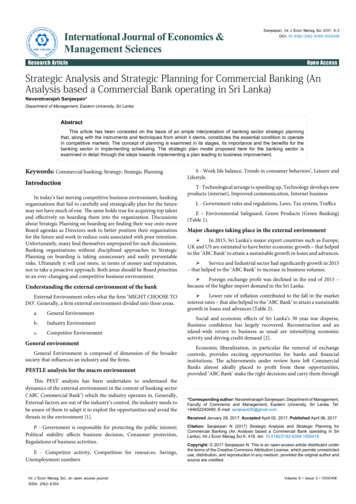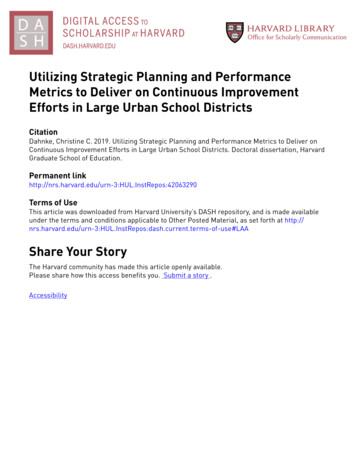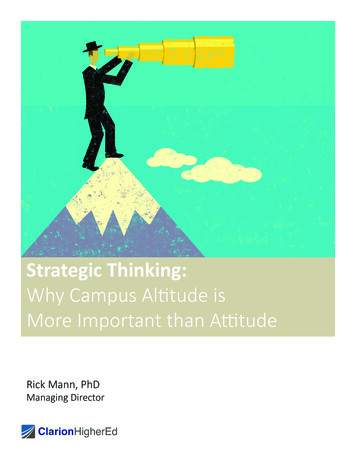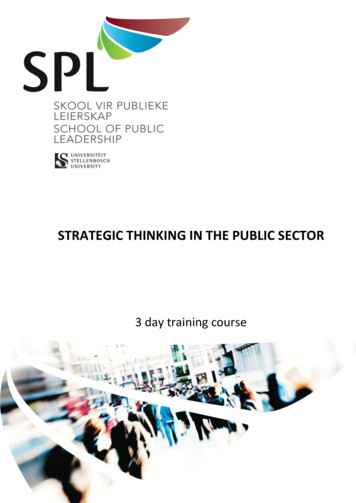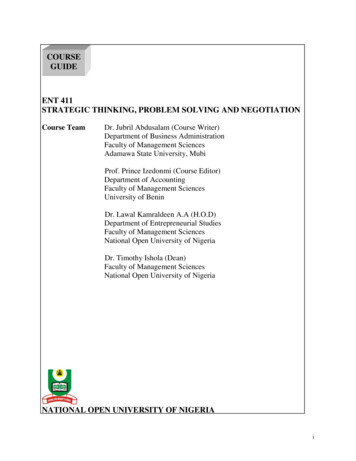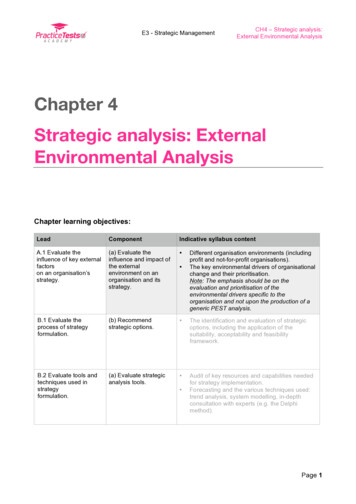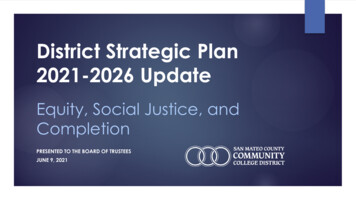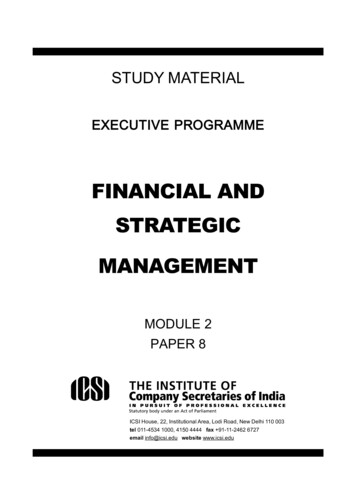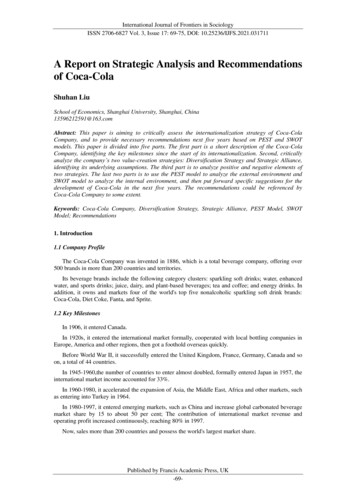
Transcription
International Journal of Frontiers in SociologyISSN 2706-6827 Vol. 3, Issue 17: 69-75, DOI: 10.25236/IJFS.2021.031711A Report on Strategic Analysis and Recommendationsof Coca-ColaShuhan LiuSchool of Economics, Shanghai University, Shanghai, China13596212591@163.comAbstract: This paper is aiming to critically assess the internationalization strategy of Coca-ColaCompany, and to provide necessary recommendations next five years based on PEST and SWOTmodels. This paper is divided into five parts. The first part is a short description of the Coca-ColaCompany, identifying the key milestones since the start of its internationalization. Second, criticallyanalyze the company’s two value-creation strategies: Diversification Strategy and Strategic Alliance,identifying its underlying assumptions. The third part is to analyze positive and negative elements oftwo strategies. The last two parts is to use the PEST model to analyze the external environment andSWOT model to analyze the internal environment, and then put forward specific suggestions for thedevelopment of Coca-Cola in the next five years. The recommendations could be referenced byCoca-Cola Company to some extent.Keywords: Coca-Cola Company, Diversification Strategy, Strategic Alliance, PEST Model, SWOTModel; Recommendations1. Introduction1.1 Company ProfileThe Coca-Cola Company was invented in 1886, which is a total beverage company, offering over500 brands in more than 200 countries and territories.Its beverage brands include the following category clusters: sparkling soft drinks; water, enhancedwater, and sports drinks; juice, dairy, and plant-based beverages; tea and coffee; and energy drinks. Inaddition, it owns and markets four of the world's top five nonalcoholic sparkling soft drink brands:Coca-Cola, Diet Coke, Fanta, and Sprite.1.2 Key MilestonesIn 1906, it entered Canada.In 1920s, it entered the international market formally, cooperated with local bottling companies inEurope, America and other regions, then got a foothold overseas quickly.Before World War II, it successfully entered the United Kingdom, France, Germany, Canada and soon, a total of 44 countries.In 1945-1960,the number of countries to enter almost doubled, formally entered Japan in 1957, theinternational market income accounted for 33%.In 1960-1980, it accelerated the expansion of Asia, the Middle East, Africa and other markets, suchas entering into Turkey in 1964.In 1980-1997, it entered emerging markets, such as China and increase global carbonated beveragemarket share by 15 to about 50 per cent; The contribution of international market revenue andoperating profit increased continuously, reaching 80% in 1997.Now, sales more than 200 countries and possess the world's largest market share.Published by Francis Academic Press, UK-69-
International Journal of Frontiers in SociologyISSN 2706-6827 Vol. 3, Issue 17: 69-75, DOI: 10.25236/IJFS.2021.0317112. Value-creation Strategies used by Coca-Cola CompanyWith the adoption of strategies, entering a foreign market can be much more comfortable.Coca-Cola, as a company, is also adopting some value-creation strategies when entering a foreignmarket. The following strategies are helping the Coca-Cola Company to adapt to each foreign countryaccurately.2.1 Diversification StrategyThe most basic assumption is about cost. Diversification strategy is considered reasonable if thecost weight of the resources for the company needs and develops is higher than the cost of thecompany's own production and manufacturing in accordance with the free allocation of the market.Coca-Cola has more than 3,300 beverages in its portfolio, ranging from diet and regular bubbles tojuices, beverages, water, sports and energy drinks, tea and coffee.The product diversification strategy describes any changes to the current product. It's a process thatinvolves building a new foundation for customers, the way they communicate the potential of theproduct. This process is achieved through brand extension or new brand implementation.Brands such as Coca-Cola, Diet Coca-Cola, Sprite, and Fanta, are part of the traditional offer ofsparkling beverages. Products in this category represent a significant segment. They offer consumers asatisfying and enjoyable solution to keep good hydration.One of the best product launches in the history of the Coca-Cola Company is Coca-Cola Zero. In2009, Coca-Cola said it sold more than 600 million cases worldwide. In 2016, Coca-Cola introducedFanta Lemon C in Japan. The drink, which contains high levels of vitamin C, is being marketed toincrease fanta's brand sales and also to meet consumer demand for more vitamin C.In New Zealand 2014, Coca-Cola Company introduced MOST. MOST is a range of 100% organicjuices that is created from organic New Zealand apples. It is targeted for urban and sophisticated adultsand cafe dwellers. It is available in 275 ml bottles and different flavors like apple, apple, orange andmango, apple and peach, .etc. Today MOST juices are the most profitable part of the New Zealandjuice portfolio and continue its growth every year.2.2 Strategic AllianceIts underlying assumptions are two or more independent enterprises, in order to achieve theestablished strategic objectives and share the benefits brought by the alliance, and can exist in variousorganizational forms.A typical approach is to form a joint venture. Despite political, cultural, competitive, and economicdifferences, companies can collaborate with local companies that will help them.Coca-Cola in Kenya includes a joint venture with six other companies. They are producing juiceslike Minute maid, and these six companies in Kenya include Cola Juice Company (CCC), which is ajoint venture between these companies: Nairobi Bottlers, Mt. Kenya Bottlers, Kisi Bottlers, EquatorBottlers, Coastal Bottlers, and Rift Valley Bottlers, and The Coca-Cola Company (TCCC).Gomez (2002) describes Coca-Cola's joint venture in Peru in his paper. Their main competitor inPeru is Inca Cola. It was introduced before what became known as Coca-Cola. After the twocompanies' battle for market share ended, Coca-Cola bought a 50 percent stake in Inca Coke and alsoacquired a 40 percent stake in Inca Coke. All bottling rights were granted to the company, which isCoca-Cola's sole bottler in Peru. Later, Coca-Cola introduced Inka Cola to other countries with itsmarketing strategy. In this way, through the strategic alliance, Coca Cola Company completely hasprecious resources.3. Positive and Negative Elements of the Strategies3.1 Diversification Strategy3.1.1 Positive Elements3.1.1.1 Expansion of Economic BenefitsPublished by Francis Academic Press, UK-70-
International Journal of Frontiers in SociologyISSN 2706-6827 Vol. 3, Issue 17: 69-75, DOI: 10.25236/IJFS.2021.031711Generally speaking, the cost of joint production is less than the sum of the costs of individualproduction. In addition, enterprise multiple businesses can share enterprise resources. For example, inthe aspect of raw materials, the original suppliers can be used for cooperation; in the aspect of sales, theenterprise can use the existing customer knowledge to save the expense of advertising and so on.3.1.1.2 Diversification of Business RisksAn important purpose of diversification strategy is to achieve the purpose of risk diversification byreducing the volatility of corporate profits. For this purpose, an enterprise can avoid the weakness that asingle business scope makes it too dependent on a certain market and prone to fluctuations. When anenterprise suffers a setback in a certain product or business field, it can make up for the loss throughsuccessful operation in other products or industries, so as to improve the ability of the enterprise toresist risks.3.1.1.3 Borrow the Reputation of the Company's Brand in New BusinessUsing a company's image and reputation in one market to enter another is crucial to success inanother.3.1.2 Negative Elements3.1.2.1 Dispersed Enterprise ResourcesThe resources owned by any enterprise are always limited, and the diversification strategy willinevitably lead the enterprise to spread the limited resources to each business area. As a result, it isdifficult to get sufficient resources to support each field of development, and it loses advantages in thecompetition with the corresponding specialized competitors.3.1.2.2 Increased Operating CostsOn the one hand, from a management domain to another domain development, starting from theinput resources, management to the production efficiency, there is a difficult, even is a long process,enterprises should abandon everything I already familiar with, and from the learning technology,production, marketing, management, operation and environment coordination, etc., this process willproduce a lot of extra costs and ultimately its benefits.On the other hand, jumping from one area of business to another unrelated area of business maylead to a huge cost of gaining customer awareness.3.1.2.3 Industry Exit RiskCompanies often give little thought to exiting before diversifying. However, if a company getsstuck in a bad investment project and fails to make a clean break, it may be wiped out.Generally speaking, it is an objective necessity for enterprises to develop towards diversification.But it must not be excessive, lest fall into diversification trap. The diversification strategy should beadopted to further enhance the core competitiveness and expand the strategic resources of theenterprise.3.2 Strategic Alliance3.2.1 Positive Elements3.2.1.1 The Collaboration is ComplementaryEvery enterprise has its comparative advantage and comparative disadvantage. Only by maintainingthe competitive advantage and overcoming the comparative disadvantage in development can anenterprise survive in the survival of the fittest in the market.Strategic alliance is a good opportunity to establish a learning organization. Both parties can makeup for the deficiency of their own enterprise development in cooperation and constantly improve theirown production, marketing and management systems.3.2.1.2 Share Risks and CostsResearch and development is a long and costly process, so enterprises bear huge risks. Strategicalliance can help enterprises speed up information transmission and acquire new technologies, so as toavoid risks in time.Published by Francis Academic Press, UK-71-
International Journal of Frontiers in SociologyISSN 2706-6827 Vol. 3, Issue 17: 69-75, DOI: 10.25236/IJFS.2021.0317113.2.1.3 Overcome Inefficient Management ModelsIf a single enterprise wants to enter the foreign market smoothly, it needs to consider the barriers toentry and other difficulties, and more importantly, it needs to overcome the low efficiency due to theexpansion of enterprise scale and the increase of management level. Strategic alliance can effectivelyrestrain the expansion of organization and improve the efficiency of enterprise organization andmanagement.3.2.2 Negative Elements3.2.2.1 Communication DisordersStrategic alliance is the combination of two companies, but in fact, it is also the integration of twocultures. Therefore, different cultural backgrounds and working methods greatly affect thecommunication between enterprises, leading to wrong information.Now, although the strategic alliance has presented a relatively mature model, we still transmissionand reception, and inconsistent goal formulation and strategic direction, thus breaking down thestrategic alliance.3.2.2.2 The Market Environment is UnstableUp to cannot ignore the impact brought by the market environment.Enterprises should pay attention to whether foreign countries restrict the form of strategic allianceand whether strategic alliance companies can effectively carry out overseas sales and transnationaltransfer of capital. An unstable market environment will inevitably affect the effective implementationof strategic alliance.3.2.2.3 The Alliance Partner is Not CorrectIf the partner is not chosen correctly, the development of the company will not be accelerated, butmore likely to result in technology spillover and loss of core competitiveness.In general, strategic alliance is a good strategy, but company should pay attention to the choice ofstrategic alliance partners and appropriate alliance way.4. Two ModelsNext, I will use the PEST model to analyze the external environment and SWOT model to analyzethe internal environment, and then put forward specific suggestions for the development of Coca-Colain the next five years.Table 1: PEST Model AnalysisPEST1. The United States has taken chaotic measures against novel coronavirus andweakened its economy, which is unstable in the face of the epidemic.2. In the face of novel coronavirus, China took the lead in implementing public healthmeasures to contain the spread of novel coronavirus, protect the population from thevirus, and then used monetary and fiscal policies to promote an economic rebound.1. As a result of the epidemic, large business groups around the world have beendownsizing their production scale this year in an effort to save costs as much aspossible, and unemployment rates have risen rapidly everywhere.2. China's post-COVID-19 economic rebound is gaining momentum, relevant data showthat China will quickly return to the growth trend before the epidemic.The epidemic has aggravated global competition. Affected by the epidemic, the socialsituation of the United States is extremely unstable, with economic developmentstagnating, unemployment rate rising rapidly, and the market demand for Coca-Coladeclining rapidly.1. Sales of fizzy drinks, notably Coke, which accounts for nearly 75% of coke's globalsales, have been falling in recent years as consumers have become morehealth-conscious.2. Too much sugar can do a lot of harm to the body, such as obesity, especially now thatpeople advocate healthy life, so coke manufacturers are actively pushing for newchanges.Published by Francis Academic Press, UK-72-
International Journal of Frontiers in SociologyISSN 2706-6827 Vol. 3, Issue 17: 69-75, DOI: 10.25236/IJFS.2021.0317114.1 Internal Environment Analysis in SWOT Model4.1.1 Strength4.1.1.1 Strong Brand IdentityCoca-Cola is a very popular brand with a unique brand identity. Its soft drinks are the best-selling inhistory and resonate with consumers of all ages.4.1.1.2 Strong Distribution NetworkCoca-Cola sells 1.9 billion products a day in more than 200 countries and has introduced more than500 new products worldwide. Coke's ability to leverage distributors owned and controlled by thecompany differs from that of independent bottlers, wholesalers and retailers. The system allows Coketo closely manage costs, quickly introduce new products to markets and saturate regional markets.4.1.1.3 Customer LoyaltyCoca-Cola has attracted a core following, and many consumers consider themselves fans of itsproducts and tend not to switch to other brands. Coca-Cola is considered one of the most emotionallyconnected brands. This valuable brand is associated with "happiness" and has strong customer loyalty.Customers can quickly identify their unique tastes, and alternatives are hard to find.4.1.1.4 Overwhelming Market ShareCoca-Cola and Pepsi are the only two largest soft drinks producers in the beverage industry, andCoca-Cola has the largest market share.4.1.1.5 AcquisitionIn 2016,Coca-Cola acquired AdeS, which is Latin America's largest soy beverage brand; In 2018, itacquired Costa, the UK's largest coffee chain. Through acquisitions, Coca-Cola has expanded itsportfolio of ready-to-drink drinks.4.1.2 Weakness4.1.2.1 Product DiversificationCoca-Cola's non-beverage products are less diversified. Pepsi has introduced a number of snacks,such as Kool, and Coke has lagged behind in this segment.4.1.2.2 Increase of Water Resource CostAs the demand for water around the world continues to rise and water resources becomeincreasingly scarce, the overall quality of available water could deteriorate significantly, resulting inhigher costs or capacity constraints for the Coca-Cola system. In the long run, this could adverselyaffect its profitability or net operating income.5. Model-based Recommendations5.1 Maintain and Expand the Brand Advantage of Coca-ColaAccording to the SWOT analysis above, the internal advantages of Coca-Cola can be seen from itsunique brand logo, iconic logo, classic red and white color, and world-renowned advertising slogan.Coca-Cola has a large number of loyal customers, who can quickly identify their unique tastes andfind it difficult to replace them. The brand of Coca-Cola is not only recognized by the majority ofconsumers, but also recognized by distributors all over the world. At present, Coca-Cola has a hugemarket share in more than 200 countries and regions. There are two major key enterprises in the Cokeindustry, and Coca-Cola still maintains its top position as the obvious winner.So in the next development plan, the first thing to do is to use its unique brand effect, and leadershipin the industry and to maintain and expand the Coca-Cola brand advantage, maintain and improvecoke's main business, stable sales in had occupied the market, and strive to occupy more market share,to maintain stable cash flow.Published by Francis Academic Press, UK-73-
International Journal of Frontiers in SociologyISSN 2706-6827 Vol. 3, Issue 17: 69-75, DOI: 10.25236/IJFS.2021.0317115.2 Market in More Remote AreasCoca-Cola should make full use of its successful distribution network and continuously improve thequality control and safety of its products. For a large company, the stability of the distribution networkhas been a great good; expand the market for Coca-Cola company to seek out in remote areas in contactwith new customers.By the SWOT analysis of Coca-Cola's acquisition of advantage and external strategic opportunitiesof PEST model,Coca-Cola in the future, should put attention more populous, and the huge marketdemand, developing countries and market share is not high in remote areas, and overseas mergers andacquisitions is Coca-Cola can quickly open a piece of one of the important means of local market.5.3 Reduce Underperforming Smaller BrandsIn the past, Coca-Cola has diversified brand has always been its proud, Coca-Cola owns more than500 brand worldwide, but at this year's outbreak, under special circumstances in the second quarter of2020, Coca-Cola's sales of 7.15 billion, while the figure in 2019 for 9.997 billion, fell 28% year onyear, the biggest quarterly decline in 25 years.The epidemic has led Coca-Cola to discover that it is not a good thing to have such a diverse rangeof brands. According to its industry analysis, Coca-Cola has too many small brands that areunderperforming globally. Among its more than 500 brands, more than half are single national brandswith little or no scale. Therefore, in the future development plan of Coca-Cola, a task that has to be puton the agenda quickly is to eliminate these small brands.In fact, Coca-Cola has already started this project, and the products it will stop producing this yearare ZICO coconut water and Hubert's lemonade.In the future, Coca-Cola should be more decisive in weeding out more of its smaller, less profitablebrands.5.4 Keep Innovating New Products to Reduce the Disadvantages of Relying Too Much on OneProductFrom the SWOT analysis above, it can be seen from the external strategic threat factors ofCoca-Cola that carbonated drinks cause two serious health problems -- obesity and diabetes, whichhave been criticized for a long time.Therefore, the next step for Coca-Cola must be to quickly withdraw funds after eliminating a largenumber of small brands, invest more research and development funds in product innovation, and adjustcorporate strategy to try to introduce healthier carbonated drinks and other products.In the past, Coca-Cola has developed some variations of Coca-Cola drinks, such as Coca-Colavanilla and cherry flavor. For example, some healthy diet Cokes without sugar have been introduced.Coke Coffee, announced by CEO James Quincey in 2019, combines Coffee with carbonated beverageswith less caffeine than Coffee and more caffeine than regular Coke. In June 2020, Innocent, invested byCoca-Cola, launched its Fresh beat Innocent products in the Chinese market.In the future, Driven by innovation, Coca-Cola will open up more new product segments. Lookingforward to the future, Coca-Cola should focus on building more relationships with coffee, energy andhealth drinks companies.5.5 Aim at the Chinese Market and Increase Investment and Business Expansion in ChinaIn the analysis of PEST model of Coca-Cola Company, one thing w1.e cannot ignore is that theglobal economy and society are affected by the epidemic, which is extremely unstable, and allindustries in various countries are affected by it.By contrast, in terms of economic situation and social stability, China is now among the countries inthe world. The economic rebound after novel coronavirus is gaining momentum. Relevant data showthat China will quickly return to the growth trend before the epidemic.Therefore, in the future, Coca-Cola should make use of its advantages to accelerate its march intothe Chinese market and strengthen its investment and market development business in China.Published by Francis Academic Press, UK-74-
International Journal of Frontiers in SociologyISSN 2706-6827 Vol. 3, Issue 17: 69-75, DOI: 10.25236/IJFS.2021.031711References[1] JANA GRGIĆ. (2020). Coca-Cola Internationalization Strategies. Undergraduate Thesis.[2] Ju Yun Chua, Daisy Mui Hung Kee. (2020). Challenges and Solutions: A Case Study of Coca-ColaCompany. Journal of the Community Development in Asia.[3] Kwemoi Cheptegei D., & Yabs J. (2016). Foreign Market Entry Strategies used by MultinationalCorporations in Kenya: A case of Coca-Cola Kenya Ltd. European Journal of Business and Strategic.[4] Kong X X. Marketing channel management of fast consumer products -- a case study of Coca-Cola.Modern Marketing (next ten-day), 2018(09):77.[5] Su Ni. On the marketing of multinational companies under the global Strategy -- a case study ofCoca-Cola Company [J]. Shopping Mall Modernization, 2018(05):51-52.[6] Wei Lihao. Coca-Cola: Pioneer of Marketing 3.0 Era -- Research on Coca-Cola creativeMarketing based on Marketing 3.0 [J]. News research guide, 2018, 9(10):62 64.][7] Zhou Qingshan, He Xingchi. Research on communication power, 2018, 2(21):34.[8] Zhang X F. Research on Coca-Cola brand Strategy based on consumer Behavior change [D].Shandong University, 2019.Published by Francis Academic Press, UK-75-
Coca-Cola Company to some extent. Keywords: Coca-Cola Company, Diversification Strategy, Strategic Alliance, PEST Model, SWOT Model; Recommendations 1. Introduction 1.1 Company Profile The Coca-Cola Company was invented in 1886, which is a total beverage company, offering over 500 brands in more than 200 countries and territories.


